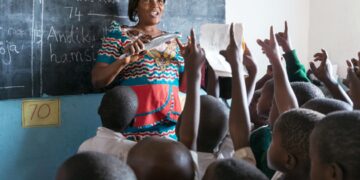A new UNICEF analysis warns that steep cuts in global education funding could leave an additional 6 million children out of school by 2026, worsening the global learning crisis. Here is what you need to know.
1. How much funding is being cut?
Education aid, also known as Official Development Assistance (ODA), is projected to fall by US\$3.2 billion by 2026. This represents a 24% drop from 2023 levels. Alarmingly, just three donor governments are responsible for nearly 80% of the cuts.
2. How many children will be affected?
The number of out-of-school children is expected to rise from 272 million to 278 million worldwide. That is the equivalent of shutting down every primary school in Germany and Italy combined.
3. Which regions are most at risk?
West and Central Africa: 1.9 million children could lose access to education.
Middle East and North Africa:1.4 million more children could be pushed out of school.
Other regions:** Significant rollbacks in progress already made.
In total, 28 countries are expected to lose at least a quarter of the education assistance they rely on. Côte d’Ivoire and Mali are among the hardest hit, facing potential enrolment declines of 4%.
4. What level of education will be hardest hit?
Primary education is expected to suffer the most, with funding projected to fall by one-third. This could strip affected children of an estimated **US\$164 billion in lifetime earnings.
5. What about education in emergencies?
In humanitarian settings—where schools often provide food, health services, and protection in addition to learning—funding could be slashed by as much as 10% of national education budgets.
In the Rohingya refugee response, 350,000 children risk losing access to basic education permanently.
Cuts could also endanger school feeding programmes, sometimes a child’s only nutritious meal.
Support for girls’ education is also expected to decline significantly.
6. How will this affect children still in school?
Even children who remain enrolled could face poorer learning outcomes. UNICEF projects that at least 290 million students worldwide could see education quality decline due to reduced investment in teachers, resources, and monitoring.
7. What does UNICEF recommend?
To prevent a crisis, UNICEF urges governments and donors to:
Allocate at least 50% of education aid to least developed countries.
Protect humanitarian education funding as a life-saving intervention.
Focus resources on early childhood and primary education, where returns are highest.
Simplify the global financing system under the UN80 Initiative.
Expand innovative financing, without replacing core funding.
Why this matters
“Every dollar cut from education is not just a budgetary decision, it’s a child’s future hanging in the balance,” said UNICEF Executive Director Catherine Russell.
Investing in education, UNICEF stresses, is one of the surest ways to reduce poverty, improve health, and build stable societies. Without urgent action, millions of children risk losing their chance to learn, grow, and escape cycles of deprivation.
















































































 EduTimes Africa, a product of Education Times Africa, is a magazine publication that aims to lend its support to close the yawning gap in Africa's educational development.
EduTimes Africa, a product of Education Times Africa, is a magazine publication that aims to lend its support to close the yawning gap in Africa's educational development.

